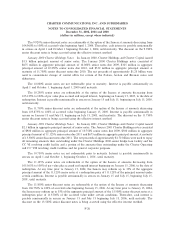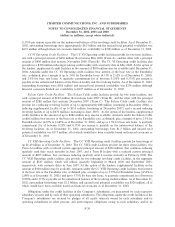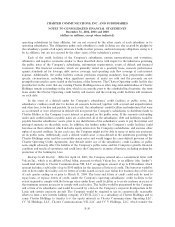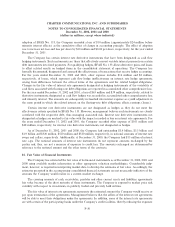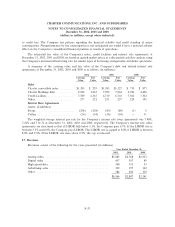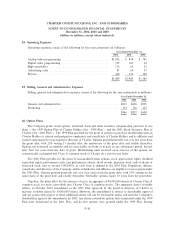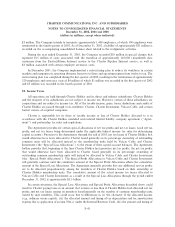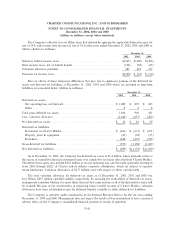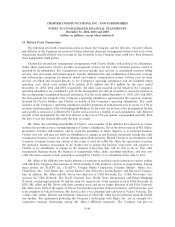Charter 2002 Annual Report Download - page 104
Download and view the complete annual report
Please find page 104 of the 2002 Charter annual report below. You can navigate through the pages in the report by either clicking on the pages listed below, or by using the keyword search tool below to find specific information within the annual report.CHARTER COMMUNICATIONS, INC. AND SUBSIDIARIES
NOTES TO CONSOLIDATED FINANCIAL STATEMENTS
December 31, 2002, 2001 and 2000
(dollars in millions, except where indicated)
adoption of SFAS No. 133, the Company recorded a loss of $10 million (approximately $24 million before
minority interest eÅects) as the cumulative eÅect of change in accounting principle. The eÅect of adoption
was to increase net loss and loss per share by $10 million and $0.04 per share, respectively, for the year ended
December 31, 2001.
The Company has certain interest rate derivative instruments that have been designated as cash Öow
hedging instruments. Such instruments are those that eÅectively convert variable interest payments on certain
debt instruments into Ñxed payments. For qualifying hedges, SFAS No. 133 allows derivative gains and losses
to oÅset related results on hedged items in the consolidated statement of operations. The Company has
formally documented, designated and assessed the eÅectiveness of transactions that receive hedge accounting.
For the years ended December 31, 2002 and 2001, other expense includes $14 million and $2 million,
respectively, of losses, which represent cash Öow hedge ineÅectiveness on interest rate hedge agreements
arising from diÅerences between the critical terms of the agreements and the related hedged obligations.
Changes in the fair value of interest rate agreements designated as hedging instruments of the variability of
cash Öows associated with Öoating-rate debt obligations are reported in accumulated other comprehensive loss.
For the year ended December 31, 2002 and 2001, a loss of $65 million and $39 million, respectively, related to
derivative instruments designated as cash Öow hedges was recorded in accumulated other comprehensive loss
and minority interest. The amounts are subsequently reclassiÑed into interest expense as a yield adjustment in
the same period in which the related interest on the Öoating-rate debt obligations aÅects earnings (losses).
Certain interest rate derivative instruments are not designated as hedges as they do not meet the
eÅectiveness criteria speciÑed by SFAS No. 133. However, management believes such instruments are closely
correlated with the respective debt, thus managing associated risk. Interest rate derivative instruments not
designated as hedges are marked to fair value with the impact recorded as loss on interest rate agreements. For
the years ended December 31, 2002 and 2001, the Company recorded other expense of $101 million and
$48 million, respectively, for interest rate derivative instruments not designated as hedges.
As of December 31, 2002, 2001 and 2000, the Company had outstanding $3.4 billion, $3.3 billion and
$1.9 billion and $520 million, $520 million and $520 million, respectively, in notional amounts of interest rate
swaps and collars, respectively. Additionally, at December 31, 2000, the Company had $15 million of interest
rate caps. The notional amounts of interest rate instruments do not represent amounts exchanged by the
parties and, thus, are not a measure of exposure to credit loss. The amounts exchanged are determined by
reference to the notional amount and the other terms of the contracts.
16. Fair Value of Financial Instruments
The Company has estimated the fair value of its Ñnancial instruments as of December 31, 2002, 2001 and
2000 using available market information or other appropriate valuation methodologies. Considerable judg-
ment, however, is required in interpreting market data to develop the estimates of fair value. Accordingly, the
estimates presented in the accompanying consolidated Ñnancial statements are not necessarily indicative of the
amounts the Company would realize in a current market exchange.
The carrying amounts of cash, receivables, payables and other current assets and liabilities approximate
fair value because of the short maturity of those instruments. The Company is exposed to market price risk
volatility with respect to investments in publicly traded and privately held entities.
The fair value of interest rate agreements represents the estimated amount the Company would receive or
pay upon termination of the agreements. Management believes that the sellers of the interest rate agreements
will be able to meet their obligations under the agreements. In addition, some of the interest rate agreements
are with certain of the participating banks under the Company's credit facilities, thereby reducing the exposure
F-36


